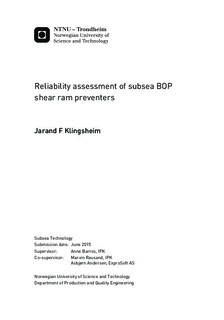| dc.description.abstract | The objective of this report is to assess the reliability of blind shear rams (BSRs). The BSR's failure to seal off and secure the well in the Macondo incident proved the necessity of reevaluating the abilities of current BSR designs.
In this report the subsea blowout preventer system description is based on the system used in the Macondo incident. Function, subsystems and classification are introduced.
A detailed description of BSRs based on Cameron's design is provided. The function is described through four probable scenarios of operation.
Standards and regulations for BSRs on the Norwegian Continental Shelf and in the US Gulf of Mexico are described and discussed. Several weaknesses were identified in the current requirements and regulations: the wording found in some instances does not encourage prudent approaches to BSR design; testing of BSRs are performed at ideal and non-realistic conditions; Code of Federal Regulation requires that deadman and autoshear systems are installed in blowout preventers, but does not have to be armed.
Changes in US regulations are likely due to a proposed rule by Bureau of Safety and Environment Enforcement. Relevant for BSRs are the following proposed changes:
- Third party verification of blowout preventer equipment through all life phases.
- Require shear rams that can center the drill pipe when shearing.
- Incorporate API 53 into the regulations.
- Incorporate other standards such as API 6A, API 16A, API 16C, API 16D and API 17D.
- Improved and consistent testing frequencies.
- Failure and near-miss reporting.
The changes proposed has the potential to eliminate some of the weaknesses of current BSRs. There are however deficiencies also in the proposed changes: there will still be too many standards to consult with overlapping and inconsistent information; and the regulations should be more rigid regarding which tubulars the BSR shall be able to shear.
Weaknesses in current BSR concepts are identified in a Failure Mode, Effect and Criticality Analysis. Results from studies of BSR capabilities are discussed and compared with the result from the analysis.
The analysis is performed on 5 different BSR functions. Two failure causes are identified to be of high criticality; drill pipe in compression; and offset/buckling drill pipe. Both causes were identified in a scenario where autoshear activates the BSRs.
Studies performed by MCS Kenny and WEST Engineering identify increased ductility and strength of drill pipes and buckling drill pipes as potential sources of BSR failure.
Two major accidents involving BSR failures are described. The Ixtoc 1 incident in 1979 released 3.1 million barrels of oil, and the Macondo incident in 2010 cost 11 lives, total loss of a drilling platform and released 4.9 million barrels of oil. In both accidents the BSR failed to shear the drill pipe and the then seal the wellbore. In 1979 a tool joint was situated across the shear path preventing the BSR from shearing. In 2010 the pipe buckled in such a way that the pipe was placed outside the shearing area of the BSR.
Studies conducted on BSR performance suffers from limited available data. The data used is partly coming from analyzing daily drilling reports, and partly from extensive searches in news media. It is recommended that a joint industry database is established for better recording of subsea blowout preventer and BSR performance.
En-Tegrity, a new BSR concept, is introduced. It has three principal differences from conventional blinds shear rams: it utilizes wellbore pressure to aid shearing; the rams are pulled instead of being pushed; and it has metal to metal sealing.
All process steps from DNV RP-A203, a industry recognized guideline for qualification of new technology, are described and performed for the En-Tegrity concept. The steps are formulated in such a way that most new BSR concepts may follow them.
The focus of the process is on setting up prudent tests. It is recommended to carry out a combination of simulation and testing to ensure cost efficiency without compromising the reliability of BSRs.
To ensure that the tests cover all possible challenging scenarios, factors influencing shearing capabilities has been divided into four categories. Combinations of categories cover all considered scenarios. Ideally all combination should be tested multiple times for each relevant tubular. This is considered unrealistic due to high costs.
The author has reduced the number of combinations by evaluating which can be omitted. It is also recommended to first perform simulations to further assess if others may be omitted. | |

